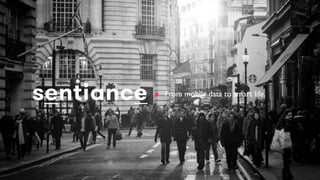Bertrand Fontaine - Deep Learning for driver/passenger detection of car trips
- 1. From mobile data to smart life.
- 2. • Which data do we collect and what information do we extract • Transport classifier • Driving behaviour characterisation • Driver passenger classification Overview
- 3. • Our clients integrate our SDK in their app • SDK detects stationaries: sends GPS fix, start/end timestamps • SDK detects transports: one GPS fix per minute, accelerometer and gyroscope sensor data • All processing done on AWS cloud Data collection
- 5. Driving behaviour profiling Aggregate User profile For each trip
- 7. • One waypoint per minute • Timestamps • Coordinates (GPS+cell tower+wifi) • Speed • Accuracy Waypoints Sensors segment trip and classify Accelerometer Gyroscope BIKING WALKING IDLE Transport data
- 9. Sensor processing for driving behaviour
- 10. Phone orientation alignment • What we want: longitudinal and lateral car accelerations, angular velocity x z x z x z y z xy Straight up Mounted In pocket On passenger seat • What we have: a phone with axes in arbitrary direction • Align the referential of the phone with the referential of the car = find rotation matrix z Gravity pull x y x Gravity pull x z y z xyKalman filter Gravity pull x y x y Gradient descent
- 11. Phone orientation alignment z rotation matrix longitudinal lateral • Compared externally with high-end inertial measurement units • As good as 100k $ hardware accelerations brakes left turn right turn
- 13. Driver vs Passenger - Context based Home Station Station Hotel Office car car car car train train car DRIVER PASSENGER • Time line chunks with transports between two home stationaries • Find consistent car cycles = closed loops where each trip starts where the previous one ended • If home in cycle -> likely driver, if not passenger
- 14. Driver specific model • Unsupervised approach utilising the derived car signals • Patterns in signals relate to how one drives • Learn a model specific for each user characterising her driving style • Feature extractor must characterise driving style but invariant to road type, traffic, weather … • One feature extractor for all user Sensors from many trips Feature vectors User-specific model Feature extraction
- 15. Feature extraction: transfer learning • We don’t want to engineer the features -> deep learning approach • No big labelled car data set annotated with driver or passenger • Transfer learning: train a network for a task, use if for another • Classify trips from 1000 users (1000 classes) • take the output of a dense layer as feature vector = projection to metric space
- 16. Feature extraction: deep learning model User finger print: • Acceleration, brake, turn events: short time scale • Temporal relationship between events Beyond 30 seconds: road layout and traffic more prominent Data augmentation (sign, additive and multiplicative noise) 2M parameters 1D convolutions input 128x1x3 3 channels
- 17. Driver vs passenger: visualising the embeddings • Users with ground truth (not used in the DL training) • Assumption: most of the time driver • Passenger are at the edge of the distribution and clustered together • Build user-specific models using those feature vectors Blue: driver Red: passenger User #1 User #2 Sensors Feature vectorsNetwork
- 18. Driver vs passenger: anomaly detection • Consider passenger trips as outliers: they differ a lot from the user’s average profile • User model = isolation forest characterising the 50 dimensional feature space • Use past trips to learn model and distribution (save user features) precision recall support passenger 0.66 0.84 25 driver 0.91 0.91 129 avg/total 0.92 0.90 154
- 19. Driver vs passenger: universal background model • Learn a gaussian mixture model for a big population = universal background model • Learn user model: for each new trip, update the universal model • Compare log likelihood of both models precision recall support passenger 0.72 0.75 24 driver 0.96 0.95 136 avg/total 0.92 0.92 180
- 20. Population results and limitations • Both approaches works best for different users • For some users, models take longer (need more data) to stabilise • Combine both approaches: recall=0.73 and precision=0.76 on passenger prediction • How good is the assumption • Number of passenger trips received at the beginning of the user model learning • Harder if passenger trips in the same car • Harder if driver trips in different cars Unsupervised driver/passenger classification
- 21. Meet the Sentiance team






















